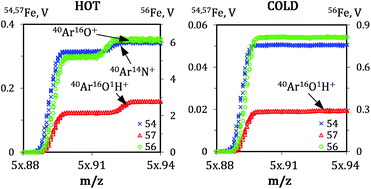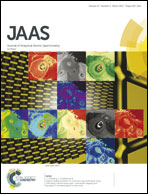Evaluation of the use of cold plasma conditions for Fe isotopic analysis via multi-collector ICP-mass spectrometry: effect on spectral interferences and instrumental mass discrimination
Abstract
The advantages and disadvantages of using cold plasma conditions in combination with both the standard and the high-transmission (‘jet’) plasma interface and under dry and wet plasma conditions were evaluated in the context of high-precision isotopic analysis of Fe via multi-collector inductively coupled plasma-mass spectrometry (MC-ICP-MS). When using the standard interface and wet plasma, cold plasma conditions suppressed the occurrence of the polyatomic ions 40Ar14N+ and 40Ar16O+, but not that of 40Ar16O1H+. Dry plasma conditions efficiently removed the (hydr)oxide ions, but at the cost of a dramatic increase in the prevalence of 40Ar14N+. Thus, interference-free 56Fe/57Fe measurement can be performed at low mass resolution using cold plasma conditions and the standard plasma interface. No alleviation of the spectral interferences due to Ar-based ions was observed with the ‘jet’ interface with cold plasma conditions. With cold plasma conditions, the instrumental mass discrimination affecting the Fe isotope ratios was mitigated compared to that obtained with hot plasma when the standard interface was used (1.4% per amu versus 3.2% per amu, respectively). This mitigation in instrumental mass discrimination with cold plasma conditions was not observed when the high-transmission interface was used.



 Please wait while we load your content...
Please wait while we load your content...